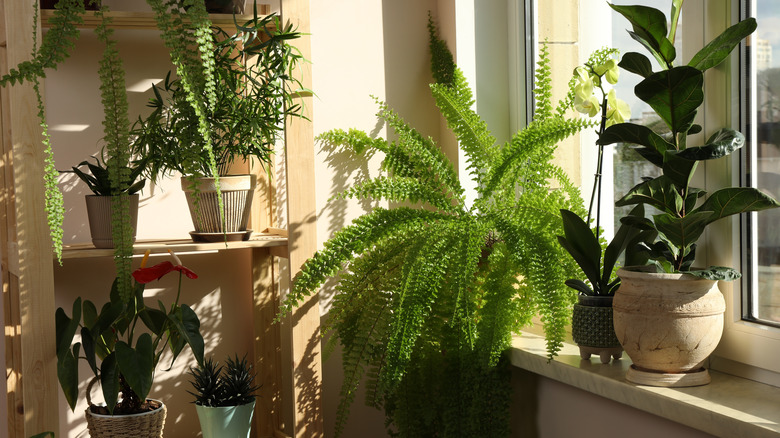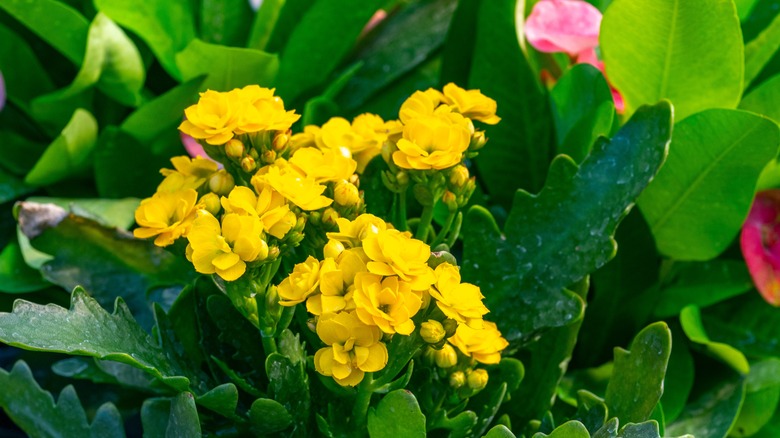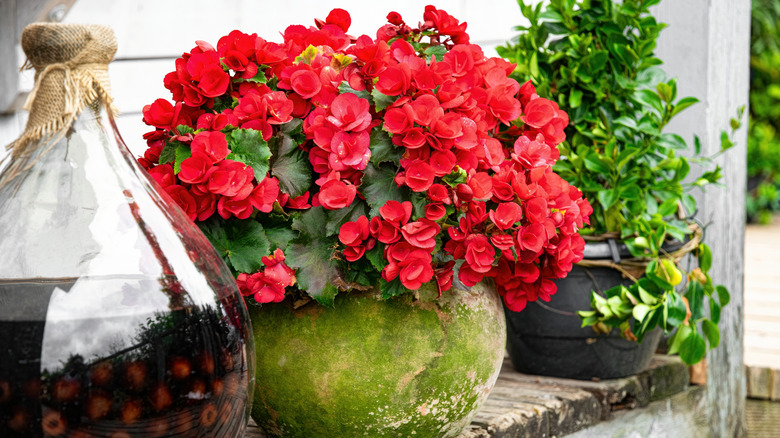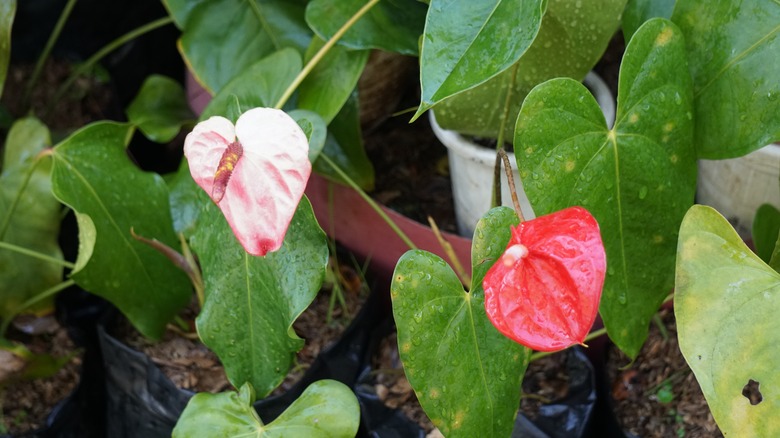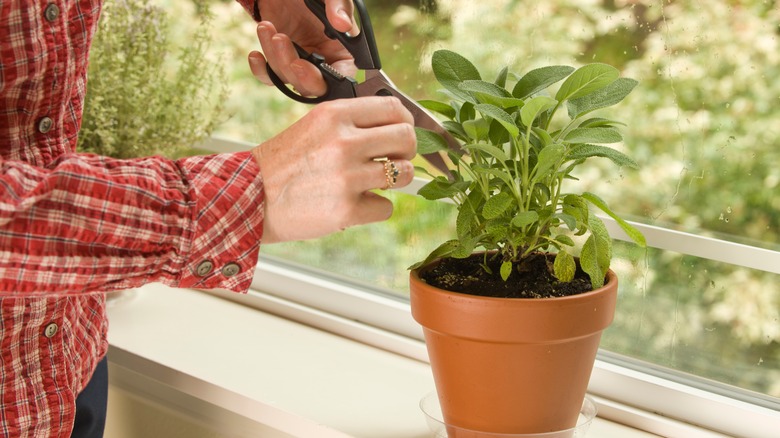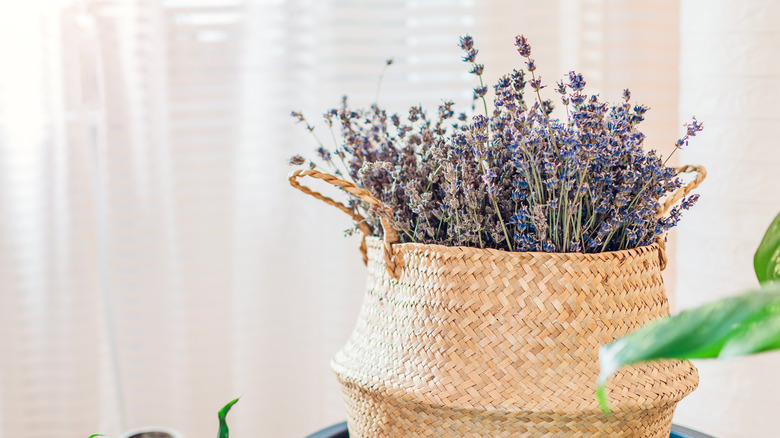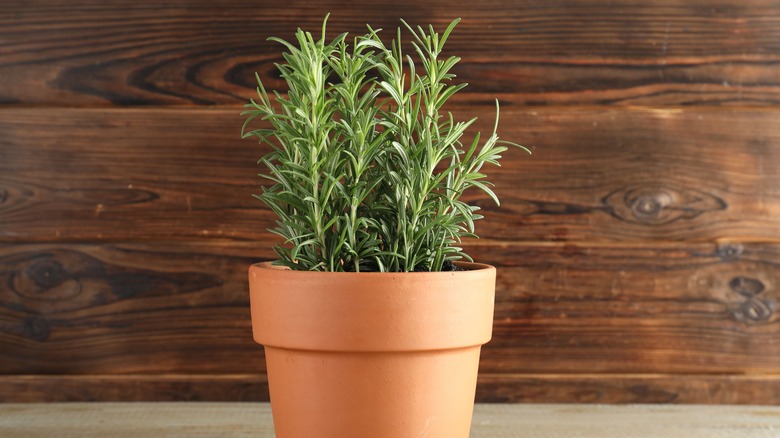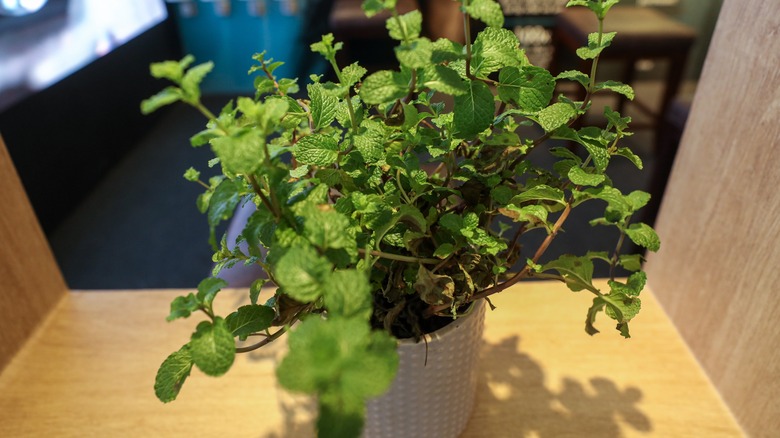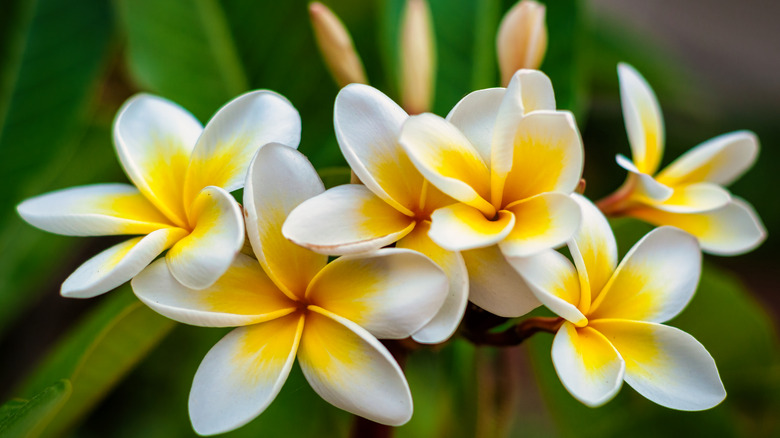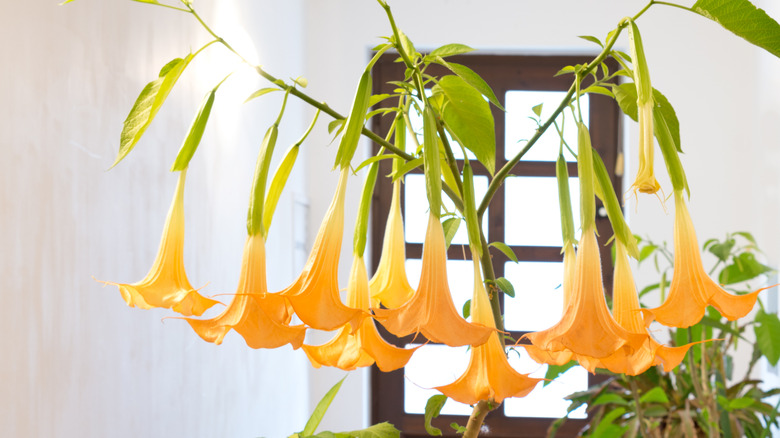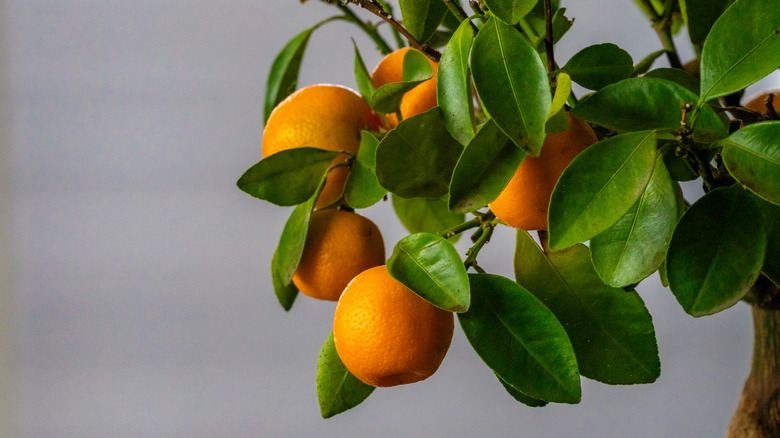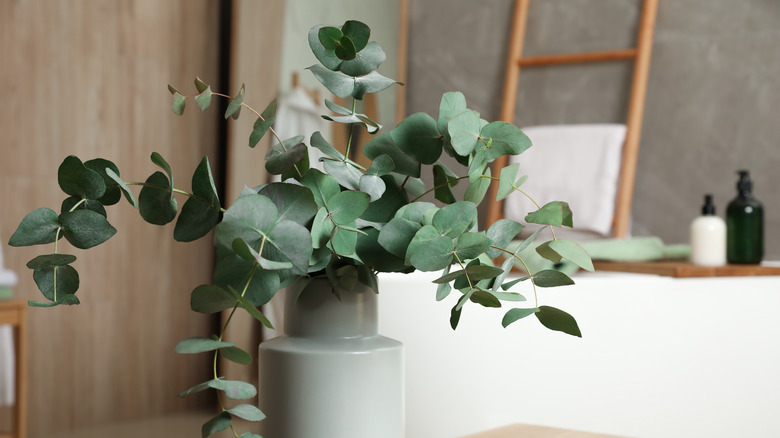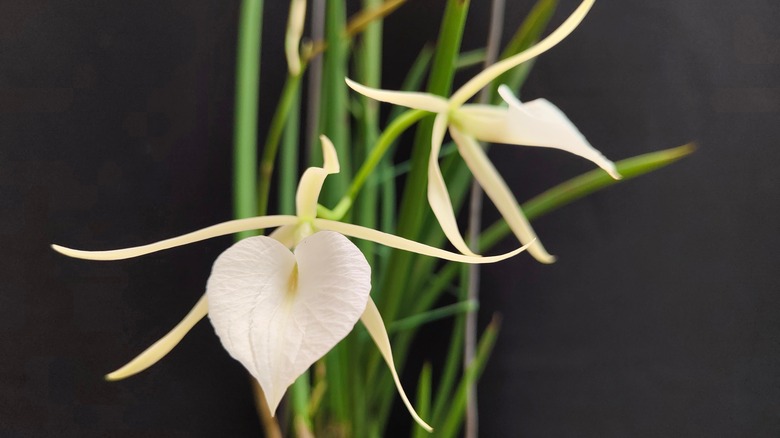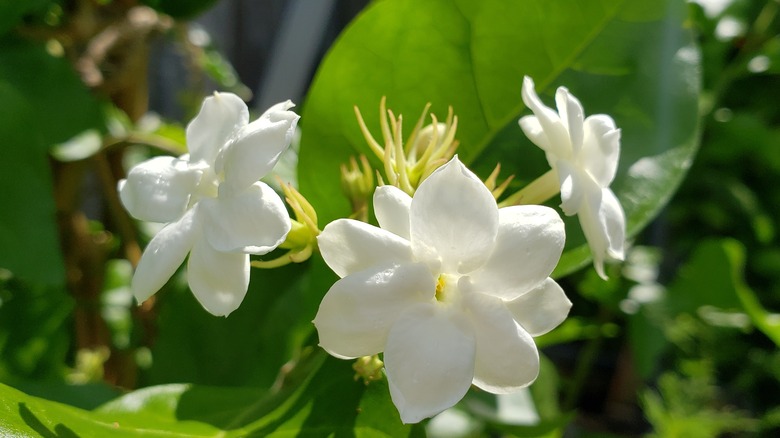16 Fall Houseplants That Will Fill Your Home With Fragrance
Growing plants indoors offers many benefits, such as helping to clean the air and improve mental health. Some species and varieties can even help to perfume your home in a natural way without having to rely on chemicals or candles, which could potentially burn down your house. Sometimes it feels like those delightful fragrances are reserved for spring and summer, leaving you with plants that don't produce beautiful blooms or pleasant smells in the other two seasons.
Thankfully, with a little research, you can easily find plenty of plants that bloom well into fall, and some even in winter, especially when grown indoors. Herbs — like sage, rosemary, and mint, for example — tend to release fragrances without the need for blooms, and can keep your home smelling amazing all year. There are flowers as well that produce beautiful blooms and scents to go with them, far into the fall season. Arabian jasmine, angel's trumpet, and begonias are just a few examples that will bring the bright bursts of color, greenery, and flowers into your home, even when fall creeps its way in and most things outside start to die. And, while some of them can be rather difficult to grow, there are plenty of easy bloomers, even for those struggling to get their green thumb to work as well as they might want.
Kalanchoe
Kalanchoes (Kalanchoe spp.) tend to bloom in the fall and winter months, generally between November and May. These plants have big, waxy leaves and colorful blooms that range from pinks and reds to oranges and yellows. When the flowers bloom, you are in for a delightful scent, described as being similar to gardenias or reminiscent of honey. There are many varieties to choose from, and only some are fragrant. For example, Kalanchoe thyrsiflora has beautiful yellow flowers and is known for its scent. However, be careful growing any kalanchoe indoors, as they are toxic to pets.
Calatheas
Calatheas (Calathea spp.) are beautiful plants more known for their large and detailed leaves than their flowers. Some blooms are similar to plumerias, however, and also have a somewhat citrusy fragrance when they flower. However, it is pretty hard to get them to bloom indoors. So, unless you are an expert, it may not be worth trying to grow these specifically for their scent. You have to be careful with which Calathea you get, as some produce a very unpleasant odor, often compared to cat pee if you don't wipe down the leaves regularly.
Begonia
If calatheas are sounding too difficult, you can ditch these high-maintenance plants for a better alternative: Begonias (Begonia spp.). Unlike their more difficult counterparts, these beautiful flowers bloom often, depending on the species. Of course, not every begonia has a scent. However, those that do release a pleasant perfume are often described as being similar to roses or oranges and are sweet-smelling. One amazing example is 'Tea Rose' (Begonia fibrous hybrid). It has fragrant pink flowers and isn't hard to care for at all. Take time to research the various options and see what works best.
Anthuriums
Anthuriums (Anthurium spp.), also known as flamingo flowers, are one of several houseplants perfect for growing indoors. They come in a range of scents and can bloom all year long when inside. Some have been described as smelling akin to blueberries or mangos, while others are compared to the smell of marzipan. However, like other plants on this list, there are a few with some rather unpleasant odors, such as wet dog or even vomit. However, there is a push to create varieties with stronger fragrances, so more options may be available in the future.
Sage
Sage (Salvia officinalis) is a beautiful plant with softly fuzzy leaves. It also tends to have a strong earthy smell. If you want a scent a little richer than the normal flowers, but that still leaves your home smelling amazing, sage is a great choice. It's a unique fragrance, but it's more herby and earthy, rather than sweet and floral. However, there are sometimes notes of lavender. It's a great option for a year-round scent that isn't too overpowering or sweet. There are many varieties available, and most have similar undertones with slightly different notes.
Lavender
Not everyone likes the smell of lavender (Lavandula spp.) in candles and perfumes. In these forms, it's a strong scent that can easily get overwhelming. However, the plant itself, while it does have some fragrance, is not overwhelming. In fact, often, the scent doesn't permeate the air unless you mess with the leaves or the flowers. Additionally, there are several different kinds, and each has slightly different fragrances and strengths, so you can find one that works best for you. French lavender (Lavandula dentata) is a great option, though it isn't as fragrant as English lavender (Lavandula angustifolia).
Rosemary
Rosemary (Salvia rosmarinus) is another option to deviate from a floral scent. If you've ever had rosemary in a dish, you know it has a strong odor. Though it's often described as pungent and astringent, it's not a bad smell at all. And, if it's ever not as strong as you want, all you have to do is crush the leaves a little as you walk by to refresh the air. Getting this plant started as well isn't hard, especially if you take the time to choose the best pot for your indoor rosemary plants.
Mint
Mint (Mentha spp.) is not only a fragrant plant that is at its peak at the beginning of fall, but it's also a great herb to help keep you warm when the temperatures drop. Pluck a few leaves and put them in hot water to make a delicious herbal tea to keep you warm and settle an upset stomach. All mint varieties contain the oil that gives these plants their smell, known as menthol. However, cultivars provide slightly different fragrances, with some smelling like lemon, chocolate, or apple. There is a mix of sweet and savory scents as well.
Lemon Cypress
As the name suggests, the lemon cypress (Hesperocyparis macrocarpa 'Goldcrest') tends to smell a little lemony. It doesn't constantly exude the scent, though. Instead, you have to rub the leaves to release the oils, making it nice for people who prefer minimal smells but want something pleasant still. Though it's a tree, there are dwarf varieties that allow you to keep it in a small pot as more of a shrub. Take the time to learn everything you should know before planting lemon cypress trees, though, to make sure it works for your home.
Frangipani
Frangipani is actually a type of plumeria, known as Plumeria rubra. These flowers bloom from late spring through November, but may bloom longer in your home as long as the temperatures stay warm. The flowers come in a variety of shades, but they generally grow in clusters, and pink, white, and yellow are the most common colors. They have a beautiful scent and are described as light, floral, and sweet, though the actual smell is hard to describe. These can turn into trees, but will thrive in a pot inside your home as long as you feed them enough.
Angel's trumpet
Angel's trumpet (Brugmansia spp.) tends to bloom at night, which is when it also releases most of its fragrance. But the scent will stick around during the day, especially if you keep these plants somewhere with lots of sun. Growing this plant indoors also offers better options. Angel's trumpet is problematic, though, and should be avoided if you have pets or children. It's incredibly poisonous, to the point that it can even kill adults if the flowers or leaves are eaten. Just take care if you want to give this plant a chance.
Calamondin orange
The Calamondin orange (Citrus x citrofortunella mitis) is an orange tree variety that's great for growing in containers and small spaces. When it's grown indoors, it doesn't always produce fruit, but it can create flowers all year long. They release a constant, fresh, and citrusy aroma that is sure to make your home smell clean and inviting. If it does produce fruit, you not only get a pleasant aroma but a delicious and slightly sour snack that you can use to replace lemons and limes in your baking, making for an overall wonderful indoor plant.
Passion flower
Passion flowers (Passiflora spp.) are vining plants that are found naturally in the southeastern part of the US, but they also work well when grown indoors. They tend to start blooming in July, but continue to flower for several months as long as the temperatures are ideal. The flowers are a charming purplish blue, with an interesting wavy shape. While some varieties don't have a scent or are rather unpleasant, there are a few delightful options, including Passiflora 'Incense', which is described as having a sweet and strong fragrance.
Eucalyptus
Eucalyptus (Eucalyptus spp.) plants are known to be large trees and shrubs in Australia, and can quickly grow out of control inside if you select the wrong variety. However, there are some species you can easily grow indoors. Focus on ones like E. citriodora, which should stay below 6 feet in a container. These plants produce constant menthol-like scents, especially when the leaves are bruised or crushed. Indoors, eucalyptus plants rarely grow flowers, but that's okay since it's the plant's leaves that produce the scent for a wonderful, fresh fragrance all year long.
Lady of the Night orchid
Lady of the Night (Brassavola nodosa) is a type of orchid perfect to grow in your home if you like to end your day on a pleasant note, as this is a beautiful orchid that will make your home smell sweeter. It tends to bloom in summer and fall, making it an ideal plant for several seasons. Its flowers are also beautiful, coming in white, occasionally with yellow or green spots. Like other orchids, though, taking care of Lady of the Night plants can be a little difficult if you aren't experienced with orchids.
Arabian Jasmine
There are many different varieties of jasmine, but Arabian jasmine (Jasminum sambac) is one of the best options for indoor growth. The Arabian variety has a beautiful smell and is perfect to grow in a bathroom. However, you can also put it in other areas of your home, too. It does have a strong fragrance, so it can be a little overwhelming, but the blooms tend to release most of their scent at night, which makes this plant more tolerable during the day. It starts blooming in summer and can continue into fall if kept warm.
